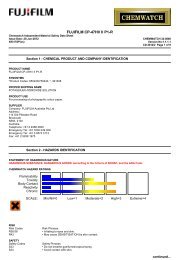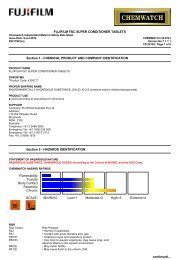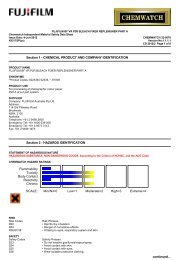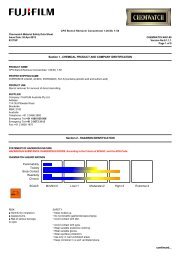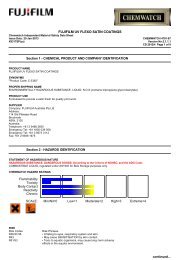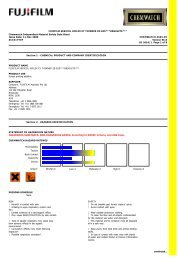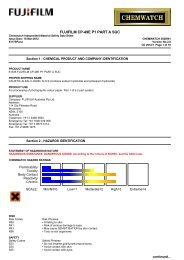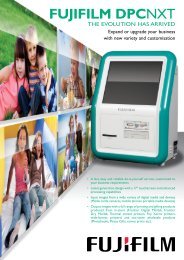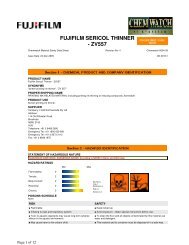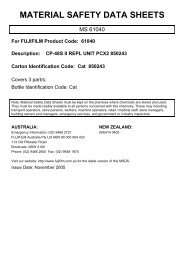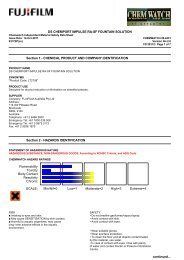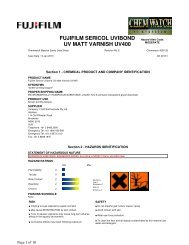Chemwatch Australian MSDS 27-6723 - FUJIFILM Australia
Chemwatch Australian MSDS 27-6723 - FUJIFILM Australia
Chemwatch Australian MSDS 27-6723 - FUJIFILM Australia
You also want an ePaper? Increase the reach of your titles
YUMPU automatically turns print PDFs into web optimized ePapers that Google loves.
<strong>FUJIFILM</strong> UVIJET ONSET OB - A<br />
<strong>Chemwatch</strong> Independent Material Safety Data Sheet<br />
Issue Date: 6-Jul-2011 CHEMWATCH <strong>27</strong>-<strong>6723</strong><br />
C9317EC<br />
Version No:2.0<br />
CD 2011/2 Page 1 of 9<br />
Section 1 - CHEMICAL PRODUCT AND COMPANY IDENTIFICATION<br />
PRODUCT NAME<br />
<strong>FUJIFILM</strong> UVIJET ONSET OB - A<br />
SYNONYMS<br />
"Product Code: OB004, OB215, ", "OB255, OB335, OB867", "printing ink"<br />
PRODUCT USE<br />
Ink jet printing ink.<br />
SUPPLIER<br />
Company: <strong>FUJIFILM</strong> <strong>Australia</strong> Pty Ltd<br />
Address:<br />
114 Old Pittwater Road<br />
Brookvale<br />
NSW, 2100<br />
<strong>Australia</strong><br />
Telephone: +61 2 9466 2600<br />
Emergency Tel: +61 1800 039 008<br />
Emergency Tel: +61 3 9573 3112<br />
Fax: +61 2 9938 1975<br />
Section 2 - HAZARDS IDENTIFICATION<br />
STATEMENT OF HAZARDOUS NATURE<br />
HAZARDOUS SUBSTANCE. NON-DANGEROUS GOODS. According to NOHSC Criteria, and ADG Code.<br />
CHEMWATCH HAZARD RATINGS<br />
Flammability<br />
Toxicity<br />
Body Contact<br />
Reactivity<br />
Chronic<br />
SCALE: Min/Nil=0 Low=1 Moderate=2 High=3 Extreme=4<br />
RISK<br />
■ Irritating to eyes, respiratory system and<br />
skin.<br />
■ May cause SENSITISATION by skin contact.<br />
■ Harmful to aquatic organisms, may cause<br />
long- term adverse effects in the aquatic<br />
environment.<br />
■ Possible risk of impaired fertility.<br />
SAFETY<br />
• Do not breathe gas/fumes/vapour/spray.<br />
• Avoid contact with skin.<br />
• Avoid contact with eyes.<br />
• Wear suitable protective clothing.<br />
• Wear suitable gloves.<br />
• Wear eye/face protection.<br />
• Use only in well ventilated areas.<br />
• Keep container in a well ventilated place.<br />
continued...
<strong>FUJIFILM</strong> UVIJET ONSET OB - A<br />
<strong>Chemwatch</strong> Independent Material Safety Data Sheet<br />
Issue Date: 6-Jul-2011 CHEMWATCH <strong>27</strong>-<strong>6723</strong><br />
C9317EC<br />
Version No:2.0<br />
CD 2011/2 Page 2 of 9<br />
Section 2 - HAZARDS IDENTIFICATION<br />
• Avoid exposure - obtain special instructions<br />
before use.<br />
• To clean the floor and all objects contaminated<br />
by this material, use water and detergent.<br />
• Keep container tightly closed.<br />
• Keep away from food, drink and animal feeding<br />
stuffs.<br />
• In case of contact with eyes, rinse with plenty<br />
of water and contact Doctor or Poisons Information<br />
Centre.<br />
• If swallowed, IMMEDIATELY contact Doctor or<br />
Poisons Information Centre. (show this container<br />
or label).<br />
• In case of accident by inhalation: remove<br />
casualty to fresh air and keep at rest.<br />
Section 3 - COMPOSITION / INFORMATION ON INGREDIENTS<br />
NAME CAS RN %<br />
dipropylene glycol diacrylate 57472-68-1 25-50<br />
hexanediol diacrylate 13048-33-4 25-50<br />
diphenyl(2, 4, 6- trimethylbenzoyl)phosphine 75980-60-8 5-10<br />
aliphatic urethane acrylate. 5-10<br />
benzophenone 119-61-9 1-5<br />
acrylated oligomer (polymer), proprietary 1-5<br />
tripropylene glycol diacrylate 42978-66-5 1-5<br />
additives, non hazardous<br />
NotSpec<br />
Section 4 - FIRST AID MEASURES<br />
SWALLOWED<br />
■ - Immediately give a glass of water.<br />
- First aid is not generally required. If in doubt, contact a Poisons Information Centre or a doctor.<br />
EYE<br />
■ If this product comes in contact with the eyes:<br />
- Wash out immediately with fresh running water.<br />
- Ensure complete irrigation of the eye by keeping eyelids apart and away from eye and moving the eyelids by occasionally lifting<br />
the upper and lower lids.<br />
- Seek medical attention without delay; if pain persists or recurs seek medical attention.<br />
- Removal of contact lenses after an eye injury should only be undertaken by skilled personnel.<br />
SKIN<br />
■ If skin contact occurs:<br />
- Immediately remove all contaminated clothing, including footwear.<br />
- Flush skin and hair with running water (and soap if available).<br />
- Seek medical attention in event of irritation.<br />
INHALED<br />
■ - If fumes or combustion products are inhaled remove from contaminated area.<br />
- Lay patient down. Keep warm and rested.<br />
- Prostheses such as false teeth, which may block airway, should be removed, where possible, prior to initiating first aid<br />
procedures.<br />
- Apply artificial respiration if not breathing, preferably with a demand valve resuscitator, bag-valve mask device, or pocket<br />
mask as trained. Perform CPR if necessary.<br />
NOTES TO PHYSICIAN<br />
■ Treat symptomatically.<br />
continued...
<strong>FUJIFILM</strong> UVIJET ONSET OB - A<br />
<strong>Chemwatch</strong> Independent Material Safety Data Sheet<br />
Issue Date: 6-Jul-2011 CHEMWATCH <strong>27</strong>-<strong>6723</strong><br />
C9317EC<br />
Version No:2.0<br />
CD 2011/2 Page 3 of 9<br />
Section 5 - FIRE FIGHTING MEASURES<br />
EXTINGUISHING MEDIA<br />
■ - Foam.<br />
- Dry chemical powder.<br />
- BCF (where regulations permit).<br />
- Carbon dioxide.<br />
FIRE FIGHTING<br />
■ - Alert Fire Brigade and tell them location and nature of hazard.<br />
- May be violently or explosively reactive.<br />
- Wear full body protective clothing with breathing apparatus.<br />
- Prevent, by any means available, spillage from entering drains or water course.<br />
FIRE/EXPLOSION HAZARD<br />
■ - Combustible.<br />
- Slight fire hazard when exposed to heat or flame.<br />
- Heating may cause expansion or decomposition leading to violent rupture of containers.<br />
- On combustion, may emit toxic fumes of carbon monoxide (CO).<br />
Combustion products include: carbon dioxide (CO2), nitrogen oxides (NOx), other pyrolysis products typical of burning organic<br />
material.<br />
May emit clouds of acrid smoke.<br />
May emit poisonous fumes.<br />
May emit corrosive fumes.<br />
FIRE INCOMPATIBILITY<br />
■ - Avoid contamination with oxidising agents i.e. nitrates, oxidising acids, chlorine bleaches, pool chlorine etc. as ignition<br />
may result.<br />
HAZCHEM<br />
None<br />
Personal Protective Equipment<br />
Breathing apparatus.<br />
Gas tight chemical resistant suit.<br />
Limit exposure duration to 1 BA set 30 mins.<br />
Section 6 - ACCIDENTAL RELEASE MEASURES<br />
MINOR SPILLS<br />
■ - Remove all ignition sources.<br />
- Clean up all spills immediately.<br />
- Avoid breathing vapours and contact with skin and eyes.<br />
- Control personal contact by using protective equipment.<br />
MAJOR SPILLS<br />
■ - DO NOT touch the spill material.<br />
Moderate hazard.<br />
- Clear area of personnel and move upwind.<br />
- Alert Fire Brigade and tell them location and nature of hazard.<br />
- Wear breathing apparatus plus protective gloves.<br />
- Prevent, by any means available, spillage from entering drains or water course.<br />
Personal Protective Equipment advice is contained in Section 8 of the <strong>MSDS</strong>.<br />
Section 7 - HANDLING AND STORAGE<br />
PROCEDURE FOR HANDLING<br />
■ - Most acrylic monomers have low viscosity therefore pouring, material transfer and processing of these materials do not<br />
necessitate heating.<br />
- Viscous monomers may require heating to facilitate handling. To facilitate product transfer from original containers, product<br />
must be heated to no more than 60 deg. C. (140 F.), for not more than 24 hours.<br />
- Do NOT use localised heat sources such as band heaters to heat/ melt product.<br />
- Do NOT use steam .<br />
continued...
<strong>FUJIFILM</strong> UVIJET ONSET OB - A<br />
<strong>Chemwatch</strong> Independent Material Safety Data Sheet<br />
Issue Date: 6-Jul-2011 CHEMWATCH <strong>27</strong>-<strong>6723</strong><br />
C9317EC<br />
Version No:2.0<br />
CD 2011/2 Page 4 of 9<br />
Section 7 - HANDLING AND STORAGE<br />
- DO NOT allow clothing wet with material to stay in contact with skin.<br />
- Avoid all personal contact, including inhalation.<br />
- Wear protective clothing when risk of exposure occurs.<br />
- Use in a well-ventilated area.<br />
- Prevent concentration in hollows and sumps.<br />
SUITABLE CONTAINER<br />
■ - Metal can or drum<br />
- Packaging as recommended by manufacturer.<br />
- Check all containers are clearly labelled and free from leaks.<br />
STORAGE INCOMPATIBILITY<br />
■ - Polymerisation may occur slowly at room temperature.<br />
- Storage requires stabilising inhibitor content and dissolved oxygen content to be monitored. Refer to manufacturer's<br />
recommended levels.<br />
- DO NOT overfill containers so as to maintain free head space above product.<br />
- Blanketing or sparging with nitrogen or oxygen free gas will deactivate stabiliser.<br />
- Store below 38 deg. C.<br />
- Contamination with polymerisation catalysts - peroxides, persulfates, oxidising agents - also strong acids, strong alkalies,<br />
will cause polymerisation with exotherm - generation of heat.<br />
- Polymerisation of large quantities may be violent - even explosive.<br />
for multifunctional acrylates:<br />
- Avoid exposure to free radical initiators (peroxides, persulfates) , iron, rust, oxidisers, and strong acids and strong bases.<br />
- Avoid heat, flame, sunlight, X-rays or ultra-violet radiation.<br />
- Storage beyond expiration date, may initiate polymerisation. Polymerisation of large quantities may be violent (even explosive).<br />
STORAGE REQUIREMENTS<br />
■ - Polymerisation may occur slowly at room temperature.<br />
- Storage requires stabilising inhibitor content and dissolved oxygen content to be monitored. Refer to manufacturer's<br />
recommended levels.<br />
- DO NOT overfill containers so as to maintain free head space above product.<br />
- Blanketing or sparging with nitrogen or oxygen free gas will deactivate stabiliser.<br />
Rotate all stock to prevent ageing. Use on FIFO (First In-First Out) basis.<br />
- Store below 38 deg. C.<br />
- Store in original containers.<br />
- Keep containers securely sealed.<br />
- No smoking, naked lights or ignition sources.<br />
- Store in a cool, dry, well-ventilated area.<br />
Section 8 - EXPOSURE CONTROLS / PERSONAL PROTECTION<br />
EXPOSURE CONTROLS<br />
The following materials had no OELs on our records<br />
• dipropylene glycol diacrylate: CAS:57472- 68- 1<br />
• hexanediol diacrylate: CAS:13048- 33- 4<br />
• diphenyl(2, 4, 6- trimethylbenzoyl)phosphine: CAS:75980- 60- 8 CAS:596818- 40- 5<br />
• benzophenone: CAS:119- 61- 9<br />
• tripropylene glycol diacrylate: CAS:42978- 66- 5 CAS:68901- 05- 3<br />
PERSONAL PROTECTION<br />
RESPIRATOR<br />
•Type A-P Filter of sufficient capacity. (AS/NZS 1716 & 1715, EN 143:2000 & 149:2001, ANSI Z88 or national equivalent)<br />
EYE<br />
■ - Safety glasses with side shields.<br />
- Chemical goggles.<br />
- Contact lenses may pose a special hazard; soft contact lenses may absorb and concentrate irritants. A written policy document,<br />
describing the wearing of lens or restrictions on use, should be created for each workplace or task. This should include a review<br />
of lens absorption and adsorption for the class of chemicals in use and an account of injury experience. Medical and first-aid<br />
personnel should be trained in their removal and suitable equipment should be readily available. In the event of chemical<br />
exposure, begin eye irrigation immediately and remove contact lens as soon as practicable. Lens should be removed at the first<br />
continued...
<strong>FUJIFILM</strong> UVIJET ONSET OB - A<br />
<strong>Chemwatch</strong> Independent Material Safety Data Sheet<br />
Issue Date: 6-Jul-2011 CHEMWATCH <strong>27</strong>-<strong>6723</strong><br />
C9317EC<br />
Version No:2.0<br />
CD 2011/2 Page 5 of 9<br />
Section 8 - EXPOSURE CONTROLS / PERSONAL PROTECTION<br />
signs of eye redness or irritation - lens should be removed in a clean environment only after workers have washed hands<br />
thoroughly. [CDC NIOSH Current Intelligence Bulletin 59], [AS/NZS 1336 or national equivalent].<br />
HANDS/FEET<br />
■ NOTE:<br />
- The material may produce skin sensitisation in predisposed individuals. Care must be taken, when removing gloves and other<br />
protective equipment, to avoid all possible skin contact.<br />
- Contaminated leather items, such as shoes, belts and watch-bands should be removed and destroyed.<br />
Suitability and durability of glove type is dependent on usage. Important factors in the selection of gloves include: such as:<br />
- frequency and duration of contact,<br />
- chemical resistance of glove material,<br />
- glove thickness and<br />
- dexterity.<br />
General warning: Do NOT use latex gloves! Use only recommended gloves - using the wrong gloves may increase the risk:<br />
Exposure condition Short time use; (few minutes<br />
less than 0.5 hour) Little physical stress<br />
Exposure condition Medium time use; less than 4<br />
hours Physical stress (opening drums, using<br />
tools, etc.)<br />
Exposure condition Long time Cleaning<br />
operations<br />
Use of thin nitrile rubber gloves: Nitrile<br />
rubber (0.1 mm) Excellent tactibility (" feel"<br />
), powder- free Disposable Inexpensive Give<br />
adequate protection to low molecular weigh<br />
acrylic monomers<br />
Use of medium thick nitrile rubber gloves<br />
Nitrile rubber, NRL (latex) free; 0.56 mm low<br />
tactibility (" feel" ), powder free High price<br />
Gives adequate protection for most acrylates in<br />
combination with commonly used solvents up to 8<br />
hours Do NOT give adequate protection to low<br />
molecular weight monomers at exposures longer<br />
than 1 hour Avoid use of ketones and acetates<br />
in wash- up solutions.<br />
.<br />
OTHER<br />
■ - Overalls.<br />
- P.V.C. apron.<br />
- Barrier cream.<br />
- Skin cleansing cream.<br />
ENGINEERING CONTROLS<br />
■ Engineering controls are used to remove a hazard or place a barrier between the worker and the hazard. Well-designed<br />
engineering controls can be highly effective in protecting workers and will typically be independent of worker interactions to<br />
provide this high level of protection<br />
The basic types of engineering controls are:<br />
Process controls which involve changing the way a job activity or process is done to reduce the risk.<br />
Enclosure and/or isolation of emission source which keeps a selected hazard "physically" away from the worker and
<strong>FUJIFILM</strong> UVIJET ONSET OB - A<br />
<strong>Chemwatch</strong> Independent Material Safety Data Sheet<br />
Issue Date: 6-Jul-2011 CHEMWATCH <strong>27</strong>-<strong>6723</strong><br />
C9317EC<br />
Version No:2.0<br />
CD 2011/2 Page 6 of 9<br />
Section 9 - PHYSICAL AND CHEMICAL PROPERTIES<br />
Upper Explosive Limit (%) Not Applicable Specific Gravity (water=1) 1.1<br />
Lower Explosive Limit (%) Not Applicable Relative Vapour Density Not Available<br />
(air=1)<br />
Volatile Component (%vol) Not Available Evaporation Rate Not Available<br />
Section 10 - STABILITY AND REACTIVITY<br />
CONDITIONS CONTRIBUTING TO INSTABILITY<br />
■ - Polymerisation may occur at elevated temperatures.<br />
- Polymerisation may be accompanied by generation of heat as exotherm.<br />
- Process is self accelerating as heating causes more rapid polymerisation.<br />
- Exotherm may cause boiling with generation of acrid, toxic and flammable vapour.<br />
For incompatible materials - refer to Section 7 - Handling and Storage.<br />
Section 11 - TOXICOLOGICAL INFORMATION<br />
POTENTIAL HEALTH EFFECTS<br />
ACUTE HEALTH EFFECTS<br />
■ Irritating to eyes, respiratory system and skin.<br />
CHRONIC HEALTH EFFECTS<br />
■ May cause SENSITISATION by skin contact.<br />
■ Possible risk of impaired fertility.<br />
TOXICITY AND IRRITATION<br />
■ unless otherwise specified data extracted from RTECS - Register of Toxic Effects of Chemical Substances.<br />
DIPROPYLENE GLYCOL DIACRYLATE:<br />
HEXANEDIOL DIACRYLATE:<br />
BENZOPHENONE:<br />
TRIPROPYLENE GLYCOL DIACRYLATE:<br />
<strong>FUJIFILM</strong> UVIJET ONSET OB - A:<br />
■ Asthma-like symptoms may continue for months or even years after exposure to the material ceases. This may be due to a nonallergenic<br />
condition known as reactive airways dysfunction syndrome (RADS) which can occur following exposure to high levels of<br />
highly irritating compound.<br />
■ Contact allergies quickly manifest themselves as contact eczema, more rarely as urticaria or Quincke's oedema. The pathogenesis<br />
of contact eczema involves a cell-mediated (T lymphocytes) immune reaction of the delayed type.<br />
DIPROPYLENE GLYCOL DIACRYLATE:<br />
HEXANEDIOL DIACRYLATE:<br />
TRIPROPYLENE GLYCOL DIACRYLATE:<br />
<strong>FUJIFILM</strong> UVIJET ONSET OB - A:<br />
■ Where no "official" classification for acrylates and methacrylates exists, there has been cautious attempts to create<br />
classifications in the absence of contrary evidence. For example<br />
Monalkyl or monoarylesters of acrylic acids should be classified as R36/37/38 and R51/53<br />
Monoalkyl or monoaryl esters of methacrylic acid should be classified as R36/37/38.<br />
■ UV (ultraviolet)/ EB (electron beam) acrylates are generally of low toxicity<br />
UV/EB acrylates are divided into two groups; "stenomeric" and "eurymeric" acrylates.<br />
The first group consists of well-defined acrylates which can be described by a simple idealised chemical;they are low molecular<br />
weight species with a very narrow weight distribution profile.<br />
The eurymeric acrylates cannot be described by an idealised structure and may differ fundamentally between various suppliers;<br />
they are of relatively high molecular weigh and possess a wide weight distribution.<br />
Stenomeric acrylates are usually more hazardous than the eurymeric substances.<br />
HEXANEDIOL DIACRYLATE:<br />
TRIPROPYLENE GLYCOL DIACRYLATE:<br />
DIPROPYLENE GLYCOL DIACRYLATE:<br />
■ Based on the available oncogenicity data and without a better understanding of the carcinogenic mechanism the Health and<br />
Environmental Review Division (HERD), Office of Toxic Substances (OTS), of the US EPA previously concluded that all chemicals<br />
that contain the acrylate or methacrylate moiety (CH2=CHCOO or CH2=C(CH3)COO) should be considered to be a carcinogenic hazard<br />
unless shown otherwise by adequate testing.<br />
This position has now been revised and acrylates and methacrylates are no longer de facto carcinogens.<br />
HEXANEDIOL DIACRYLATE:<br />
<strong>FUJIFILM</strong> UVIJET ONSET OB - A:<br />
■ The material may produce severe skin irritation after prolonged or repeated exposure, and may produce a contact dermatitis<br />
(nonallergic). This form of dermatitis is often characterised by skin redness (erythema) thickening of the epidermis.
<strong>FUJIFILM</strong> UVIJET ONSET OB - A<br />
<strong>Chemwatch</strong> Independent Material Safety Data Sheet<br />
Issue Date: 6-Jul-2011 CHEMWATCH <strong>27</strong>-<strong>6723</strong><br />
C9317EC<br />
Version No:2.0<br />
CD 2011/2 Page 7 of 9<br />
Section 11 - TOXICOLOGICAL INFORMATION<br />
DIPROPYLENE GLYCOL DIACRYLATE:<br />
TOXICITY<br />
IRRITATION<br />
Oral (rat) LD50: 4600 mg/kg<br />
Skin (rabbit): 500 mg/24h- SEVERE<br />
Dermal (rabbit) LD50: >2000 mg/kg<br />
Eye (rabbit): 100 mg - SEVERE<br />
■ The material may cause skin irritation after prolonged or repeated exposure and may produce a contact dermatitis (nonallergic).<br />
This form of dermatitis is often characterised by skin redness (erythema) and swelling epidermis.<br />
Somnolence, ataxia, diarrhoea recorded<br />
HEXANEDIOL DIACRYLATE:<br />
TOXICITY<br />
IRRITATION<br />
Oral (rat) LD50: 5000 mg/kg<br />
Skin (rabbit): 500 mg/24h SEVERE<br />
Dermal (rabbit) LD50: 3654 mg/kg Eye (rabbit): Mild *<br />
* AIHA<br />
DIPHENYL(2,4,6-TRIMETHYLBENZOYL)PHOSPHINE:<br />
TOXICITY<br />
IRRITATION<br />
Oral (rat) LD50: >5000 mg/kg * Skin (rabbit): non- irritating *<br />
Eye (rabbit): non- irritating *<br />
BENZOPHENONE:<br />
TOXICITY<br />
Oral (rat) LD50: >10, 000 mg/kg<br />
Oral (mouse) LD50: 2895 mg/kg<br />
Dermal (rabbit) LD50: 3535 mg/kg<br />
IRRITATION<br />
Nil Reported<br />
TRIPROPYLENE GLYCOL DIACRYLATE:<br />
TOXICITY<br />
IRRITATION<br />
Oral (rat) LD50: 6200 mg/kg<br />
Skin (rabbit): 500 mg/24h Moderate<br />
Dermal (rabbit) LD50: >2000 mg/kg Draize = 2.5/8.0 *<br />
Intraperitoneal (Rat) LD50: 345 mg/kg<br />
Eye (rabbit): 100 uL/24h SEVERE<br />
Intraperitoneal (Rabbit) LD: <strong>27</strong>5 mg/kg * [Manufacturer H]<br />
■ The material may produce severe irritation to the eye causing pronounced inflammation. Repeated or prolonged exposure to<br />
irritants may produce conjunctivitis.<br />
The material may cause skin irritation after prolonged or repeated exposure and may produce a contact dermatitis (nonallergic).<br />
This form of dermatitis is often characterised by skin redness (erythema) and swelling the epidermis.<br />
Section 12 - ECOLOGICAL INFORMATION<br />
Harmful to aquatic organisms, may cause long-term adverse effects in the aquatic environment.<br />
Ecotoxicity<br />
Ingredient Persistence: Persistence: Air Bioaccumulation Mobility<br />
Water/Soil<br />
Fujifilm Uvijet Onset OB - A No Data No Data<br />
Available<br />
Available<br />
dipropylene glycol diacrylate LOW No Data LOW MED<br />
Available<br />
hexanediol diacrylate No Data No Data<br />
Available<br />
Available<br />
diphenyl(2, 4, 6- HIGH No Data LOW LOW<br />
trimethylbenzoyl)phosphine<br />
Available<br />
benzophenone HIGH No Data LOW MED<br />
Available<br />
tripropylene glycol diacrylate HIGH No Data LOW HIGH<br />
Available<br />
Section 13 - DISPOSAL CONSIDERATIONS<br />
■ - Containers may still present a chemical hazard/ danger when empty.<br />
- Return to supplier for reuse/ recycling if possible.<br />
Otherwise:<br />
- If container can not be cleaned sufficiently well to ensure that residuals do not remain or if the container cannot be used to<br />
store the same product, then puncture containers, to prevent re-use, and bury at an authorised landfill.<br />
continued...
<strong>FUJIFILM</strong> UVIJET ONSET OB - A<br />
<strong>Chemwatch</strong> Independent Material Safety Data Sheet<br />
Issue Date: 6-Jul-2011 CHEMWATCH <strong>27</strong>-<strong>6723</strong><br />
C9317EC<br />
Version No:2.0<br />
CD 2011/2 Page 8 of 9<br />
Section 13 - DISPOSAL CONSIDERATIONS<br />
- Where possible retain label warnings and <strong>MSDS</strong> and observe all notices pertaining to the product.<br />
Legislation addressing waste disposal requirements may differ by country, state and/ or territory. Each user must refer to laws<br />
operating in their area.<br />
A Hierarchy of Controls seems to be common - the user should investigate:<br />
- Reduction.<br />
- DO NOT allow wash water from cleaning or process equipment to enter drains.<br />
- It may be necessary to collect all wash water for treatment before disposal.<br />
- In all cases disposal to sewer may be subject to local laws and regulations and these should be considered first.<br />
- Where in doubt contact the responsible authority.<br />
- Recycle wherever possible or consult manufacturer for recycling options.<br />
- Consult State Land Waste Authority for disposal.<br />
- Bury or incinerate residue at an approved site.<br />
- Recycle containers if possible, or dispose of in an authorised landfill.<br />
Section 14 - TRANSPORTATION INFORMATION<br />
HAZCHEM:<br />
None (ADG7)<br />
NOT REGULATED FOR TRANSPORT OF DANGEROUS GOODS: ADG7, UN, IATA, IMDG<br />
Section 15 - REGULATORY INFORMATION<br />
POISONS SCHEDULE None<br />
REGULATIONS<br />
Regulations for ingredients<br />
dipropylene glycol diacrylate (CAS: 57472-68-1) is found on the following regulatory lists;<br />
"<strong>Australia</strong> Inventory of Chemical Substances (AICS)"<br />
hexanediol diacrylate (CAS: 13048-33-4) is found on the following regulatory lists;<br />
"<strong>Australia</strong> Hazardous Substances","<strong>Australia</strong> Inventory of Chemical Substances (AICS)","International Council of Chemical<br />
Associations (ICCA) - High Production Volume List"<br />
diphenyl(2,4,6-trimethylbenzoyl)phosphine (CAS: 75980-60-8,596818-40-5) is found on the<br />
following regulatory lists;<br />
"<strong>Australia</strong> Inventory of Chemical Substances (AICS)"<br />
benzophenone (CAS: 119-61-9) is found on the following regulatory lists;<br />
"<strong>Australia</strong> Inventory of Chemical Substances (AICS)","<strong>Australia</strong> Therapeutic Goods Administration (TGA) Sunscreening agents<br />
permitted as active ingredients in listed products - Under Review","International Chemical Secretariat (ChemSec) REACH SIN* List<br />
(*Substitute It Now!) 1.1","International Council of Chemical Associations (ICCA) - High Production Volume List","International<br />
Fragrance Association (IFRA) Survey: Transparency List"<br />
tripropylene glycol diacrylate (CAS: 42978-66-5,68901-05-3) is found on the following<br />
regulatory lists;<br />
"<strong>Australia</strong> Hazardous Substances","<strong>Australia</strong> Inventory of Chemical Substances (AICS)","International Council of Chemical<br />
Associations (ICCA) - High Production Volume List"<br />
No data for Fujifilm Uvijet Onset OB - A (CW: <strong>27</strong>-<strong>6723</strong>)<br />
Section 16 - OTHER INFORMATION<br />
Denmark Advisory list for selfclassification of dangerous substances<br />
Substance CAS Suggested codes<br />
dipropylene glycol diacrylate 57472- 68- 1 Carc3; R40 R43<br />
Xi; R38<br />
tripropylene glycol diacrylate 68901- 05- 3 Carc3; R40 R43<br />
Xi; R38 N; R50<br />
INGREDIENTS WITH MULTIPLE CAS NUMBERS<br />
Ingredient Name<br />
CAS<br />
continued...
<strong>FUJIFILM</strong> UVIJET ONSET OB - A<br />
<strong>Chemwatch</strong> Independent Material Safety Data Sheet<br />
Issue Date: 6-Jul-2011 CHEMWATCH <strong>27</strong>-<strong>6723</strong><br />
C9317EC<br />
Version No:2.0<br />
CD 2011/2 Page 9 of 9<br />
Section 16 - OTHER INFORMATION<br />
diphenyl(2, 4, 6- trimethylbenzoyl)phosphine 75980- 60- 8, 596818- 40- 5<br />
tripropylene glycol diacrylate 42978- 66- 5, 68901- 05- 3<br />
■ Classification of the preparation and its individual components has drawn on official and authoritative sources as well as<br />
independent review by the <strong>Chemwatch</strong> Classification committee using available literature references.<br />
A list of reference resources used to assist the committee may be found at:<br />
www.chemwatch.net/references.<br />
■ The (M)SDS is a Hazard Communication tool and should be used to assist in the Risk Assessment. Many factors determine whether<br />
the reported Hazards are Risks in the workplace or other settings.<br />
This document is copyright. Apart from any fair dealing for the purposes of private study, research, review or<br />
criticism, as permitted under the Copyright Act, no part may be reproduced by any process without written<br />
permission from CHEMWATCH. TEL (+61 3) 9572 4700.<br />
Issue Date: 6-Jul-2011<br />
Print Date: 6-Jul-2011<br />
This is the end of the <strong>MSDS</strong>.



